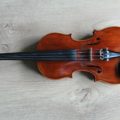It’s a good habit to inspect your violin Your Violin Bow - It's Just Elementary Physics - As your violin skills and passion develop, it's essential that your violin bow evolves with them. Your first bow was likely chosen for durability and protection against accidents, perhaps even an all-synthetic bow for your initial learning and introduction to the violin's intricacies. As you progress, it's wise to keep that initial bow as a… each time you pick it up to play. Performing a quick overall check helps prevent costly repairs in the future.
First, examine the violin’s body for fine cracks, which can result from sudden temperature and humidity changes, improper handling, or string tension.
The Violin Play the Violin - A Whole Novice's Guide - The violin, also known as a fiddle, is a bowed string instrument. It has four strings that are tuned in perfect fifths. The violin is the smallest and highest pitched member of the string instrument family, which also includes violas and cellos. Although playing the violin can be quite challenging, when mastered, it produces a… Bridge
Ensure that the bridge is in the correct position and not leaning too far. As you tune the violin using the pegs, the top of the bridge moves slightly towards them. This movement is usually small and unnoticeable, but over time, it can cause the bridge to lean towards the fingerboard due to string tension. The bridge’s correct angle can be determined by looking at the side facing the tailpiece. It should be perpendicular to an imaginary straight line or tangent starting at the point where the bridge rests on the violin’s curve. If the bridge leans too far from the perpendicular, it can warp or break. The correct position for the bridge is to align its feet between the two small notches on the inner sides of the f-holes. To adjust the bridge angle, lay the violin down on its back on a cloth or in its case. Rest your hands just above the widest part of the violin and hold the bridge between your thumb and index finger or thumb and middle finger. A considerable amount of pressure is needed to move the bridge, and this should be done slowly without shifting the feet’s position.
Inspect the fine tuners to ensure they are not touching the instrument’s wood. Check that there is a gap between each tuner and the top of the instrument, as fine tuners can cause damage by digging into the wood.
Examine the pegs, which should move smoothly but not slip excessively. If a peg sticks too much, you can loosen it with commercial peg drops, such as Hill Peg Compound. Be careful to treat one peg at a time; loosening too many strings simultaneously can potentially damage the sound post by causing uneven pressure on the instrument. If you don’t have peg drops, you can use a small, dry piece of soap to rub a tiny amount on the areas where the peg passes through the pegbox. Use sparingly! Conversely, if a peg is too loose, you can apply blackboard chalk or artist pastels to the peg, as the chalk dust will help hold the peg by creating friction. If chalk doesn’t work, it might be wise to consult a luthier to refit the pegs.
Manuel Marino is a seasoned Senior Producer, Music Composer, and Artist with over a decade of experience. He specializes in branded entertainment across various mediums, including video games, films, and advertising campaigns. With 20+ years as a game music composer, Manuel has worked on numerous platforms, creating diverse orchestral soundtracks. HIRE ME


 Manuel is a passionate, driven, and techsavvy AV technician,
Manuel is a passionate, driven, and techsavvy AV technician, 


